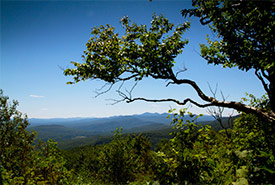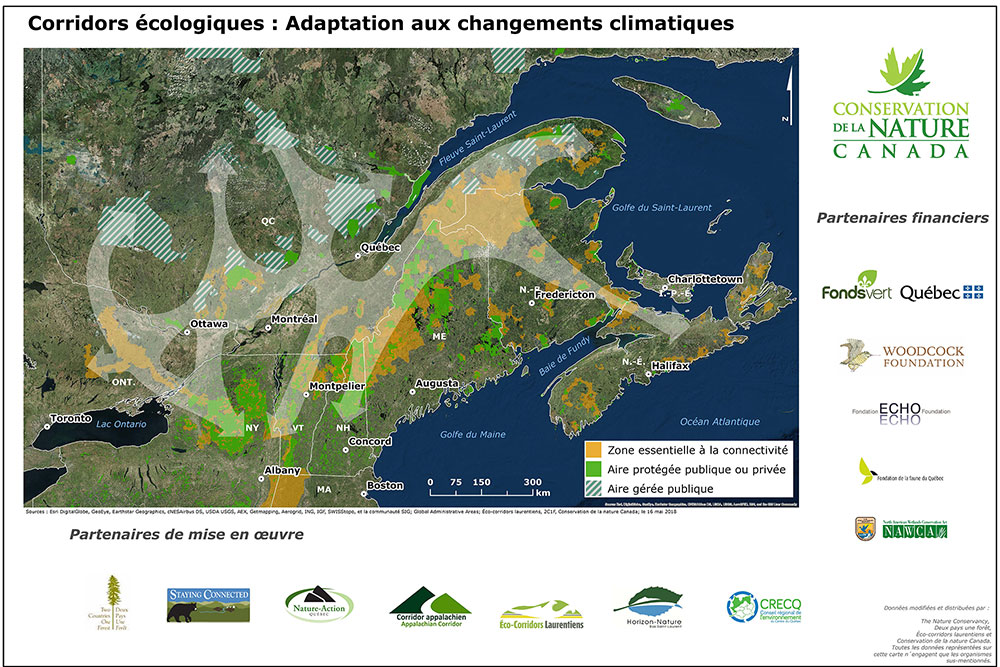Connectivity and climate change: The Fonds vert to help ecological corridors

The Green Mountains Nature Reserve, QC (Photo by Appalachian Corridor)
The Nature Conservancy of Canada (NCC), a not-for-profit conservation organization, welcomes the contribution of nearly $1 million from the Ministère du Développement durable, de l’Environnement et de la Lutte contre les changements climatiques to its Ecological corridors: a climate change adaptation strategy project.
This amount comes from the Action-Climat Québec program, financed by the Fonds vert. From now until 2020, NCC and many regional and international partners will be educating communities about the ecological corridors that cross their region.
These corridors consist of land and water passages that connect territories to each other. These so-called “connectivity” areas allow animals to move and plants to disperse to meet their needs. NCC's collaborative project aims to mobilize the population to safeguard these ecological corridors.

“The impact of climate change is putting increasing pressure on our ecosystems and all the species that comprise them. The project Ecological corridors: a climate change adaptation strategy by the Nature Conservancy of Canada in Quebec engages the community in implementing solutions to preserve our rich natural heritage. This is one of the objectives of the Action-Climat Québec program, funded by the Fonds vert: for local communities to take action to implement climate change adaptation strategies to ensure a richer and greener future for us all,” stated Isabelle Melançon, Minister of Sustainable Development, the Environment and the Fight against Climate Change.
“Under the influence of climate change, it is estimated that species habitats in Quebec will shift north by about 45 kilometres per decade,” says Joël Bonin, associate vice-president of NCC in Quebec. “The province has the potential to become a climate refuge for many species, so it has the potential to play a key role on a continental scale in adapting to climate change.”
Connectivity between habitats is essential to coping with these changes. Not only does it promote the survival of wild species, but it contributes to the well-being of humans, for whom natural environments perform an infinite number of services.
Project implementation
The project is being deployed in five Quebec regions (see map). To build a common vision for connectivity in southern Quebec, NCC works with these key organizations:
- Appalachian Corridor
- Éco-corridors laurentiens
- Nature-Action Québec
- Conseil régional de l’environnement du Centre-du-Québec
- Horizon-Nature Bas-Saint-Laurent
- Two Countries One Forest
- Staying Connected Initiative
NCC also recognizes the contribution of the Woodcock Foundation, whose landscape conservation program focuses on maintaining connectivity between Canada and the United States.

View the interactive map of connectivity projects in Quebec
“The Woodcock Foundation of New York and the Echo Foundation of Montreal are pleased to partner with the Government of Quebec's Fonds vert to support the efforts of NCC and its partners to identify wildlife corridors that will become part of the green infrastructure vital to North America’s adaptation to climate change. We look forward to working with the Fond verts to secure this infrastructure as the next step for this initiative,” said Jeremy Guth, administrator at the Woodcock Foundation.
NCC is also collaborating with an advisory committee made up of experts from various governmental and non-governmental organizations, research institutions, national parks, other land managers (including municipal and forestry representatives, among others) and citizens.
Through its interventions, the project aims to bring about changes in behaviour and encourages communities to embrace the protection of natural corridors as a climate change adaptation solution. With this in mind, community activities will be held in the five connectivity zones in order to educate and involve the population, guide them in taking action and seek solutions.
In order to maintain the corridors and promote their importance, the following three strategies are being adopted:
- Encourage the various RCMs and municipalities to take advantage of their territorial planning tools.
- Encourage forest owners and operators to use voluntary conservation or certification tools to preserve the corridors’ suitability for forestry.
- Provide the targeted regions with a network of stakeholders who can maintain and enhance the corridors.
Highlights of phase 1 (2017-2020): Check out the infosheet






